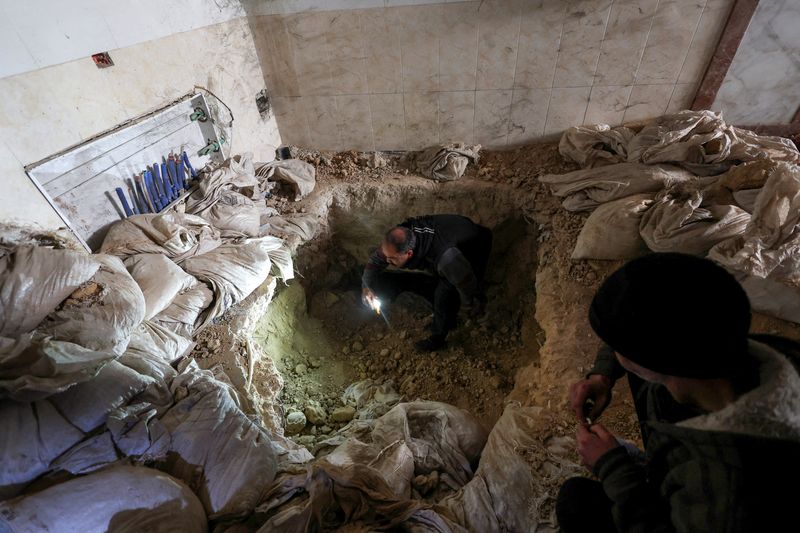By Maya Gabilli
DAMASCUS (Reuters) – A hip bone in a blown-up building, part of a spine amid some rubble, some foot bones in a damaged sock. After what residents and rights groups have described as years of killings under the regime of Syria’s Bashar al-Assad, the Tadamon district of Damascus is littered with bones.
Tadamon gained notoriety after a video surfaced in 2022 showing a man in military fatigues leading unarmed, blindfolded men toward a large ditch, telling them to run and burying them near or in the bank. Used to shoot at point-blank range after falling.
The incident took place in 2013, but the killings continued until recently, residents told Reuters, adding that they regularly saw Syrian security forces bringing men into the area, heard gunshots and later The smell of rotting flesh.
Mohammed al-Dara, an elderly man from Tadamon, said he had stayed in the neighborhood since the civil war broke out in 2011 because his family feared their apartment would be looted.
He said that year after year, he saw cars driven by the Syrian armed forces bringing “bound people” along a small street parallel to where the Tadamon massacre took place.
“At night you’ll hear it. Every bullet went into a man,” he said. “And it was a graveyard for all the dead bodies,” he added, pointing to the dirt road and broken buildings beside him.
Reuters found piles of bones amid garbage, scorched plastic and dirty clothes in buildings on both sides, and saw children playing with rib bones and femurs.
Khalid Houria, who runs a mechanic shop in the area, said he too had often heard gunshots and the smell of rotting flesh after returning to the neighborhood in 2019.
“It was known as the street of executions. Anyone who came into this street was considered lost,” he said, adding that security forces often asked his neighbors to help dig mass graves.
“Those things won’t leave our memory. Dead bodies all over the floor — it became normal for people,” Hurria said.
Too afraid to speak
Residents said they dared not speak out during Assad’s rule, when criticism of the authorities was severely suppressed. Some remained reluctant and spoke only by first name, refusing to be filmed.
“We can’t say anything, or they’ll burn your house down, or kill your son. It was ugly, ugly, ugly,” Dara said.
But now, less than a week after Assad’s ouster, residents and rights researchers hope the site can be cordoned off and those responsible for the killings held accountable.
“It is important that the site is secured, that the mass grave is exhumed, that the relevant international organizations are allowed unhindered access to the area so that this work is carried out carefully, cautiously,” said Syrian researcher Hiba Zayedin. can be done well.” Advocacy group Human Rights Watch.
Zayedin said there was a risk that the mass grave had already been emptied by forces of Assad’s fallen government. “The families deserve to know what happened here,” he said.
Millions of Syrians are estimated to have been killed since 2011, when a crackdown on protests against Assad escalated into a full-scale war drawing in regional powers.
Both Assad and his father Hafez, who was president before him and died in 2000, have been accused by rights groups and the government of widespread extrajudicial killings, including mass executions within the country’s notorious prison system.
Assad has repeatedly denied violations and described his opponents as terrorists.
In 2023, the US State Department issued a travel ban against a Syrian security official and his immediate family for the alleged killing of at least 41 civilians in Tadamon in 2013, calling it a “massacre”.
The suspected location of the grave was identified by Human Rights Watch researchers by matching satellite images with the scene in the video.
Although the site has yet to be fully investigated, the group has already found several traces of the murders.
“We found human remains, bones, part of the skull, fingers, ribs, scattered around the entire area around the mass grave, which shows that much more has actually happened than we already know,” Zayedin said. C,” said Zayedin.
Tadamon residents told Reuters that the street was sealed off with metal barricades during heavy fighting between rebel fighters and Syrian government forces, including the National Defense Forces, a pro-Assad paramilitary force that was incorporated into the army in 2012. was gone

Several said that earlier this year, they saw Syrian then-government forces remove some bones from the area and feared the grave — and important evidence — had been dug up.
The opening of Syrian prisons after Assad’s ouster on Sunday sparked similar fears, with activists and families searching for detained relatives, saying they feared fleeing forces had destroyed evidence of their fate. .










